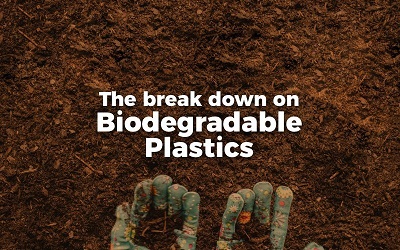Search Products
Polymer, Rubber & Paper
7 Things you should know about Biodegradable Plastic

1. Biodegradable materials are all plant based and environmentally friendly
This isn’t always the case. Biodegradable plastics can be made from naturally based materials such as corn starch Polylactic Acid (PLA), but some are produced using petrochemicals containing biodegradable additives that enhance biodegradation.
2. Biodegradable plastics have the ability to break down quickly and decompose over time
So strictly the definition of biodegradation is the disintegration of materials by microorganisms such as bacteria, fungi or other biological means. But when it comes to packaging materials there is no set definition of ‘biodegradability.’
Industrial vs Home Composting 2
Some biodegradable materials don’t biodegrade, others require extremely specific conditions and even then, bioplastics made with petrochemicals can leave behind toxins and small plastic residue that contaminates the soil and makes it unsuitable for composting.
3. We’re looking at biodegradable plastics because we want our customers to be able to compost their packaging at home
There needs to be scientific evidence to support the fact that packaging can biodegrade over time in the type of conditions typically found in a home composter.
If a material is truly biodegradable, the packaging may have a number of certifications. In the UK, there are several certifications that let customers know they are suitable for industrial composting or composting at home.
4. Plastic is hardly ever recycled or disposed of responsibly but biodegradable plastic can be disposed of responsibly
In theory, yes. However, the majority of biodegradable plastics available on the market today are only certified to decompose in ‘industrial facilities.’ Which sounds great, but consumers soon encounter problems when locating their nearest industrial composting facility, as there won’t be a curbside collection arranged by local authorities any time soon.
Many consumers may also place the biodegradable plastic into the plastic recycling bin. This not only contaminates the plastic waste stream, but it can also undermine and distract from the efforts to improve plastic recycling infrastructure.
Failing both of the above, the material may still end up in the usual landfill sites, making the whole process a waste of time, money and resources.
5. At least when it makes its way to a landfill, it will biodegrade faster than plastic
Firstly, there have never really been any conclusive tests that tell us for a fact, how long plastic takes to completely break down. What we do know is that nothing degrades in a landfill, and even if biodegradable plastics did manage to break down somewhat they would release methane, a greenhouse gas more damaging to the environment than CO2.
Biodegradable Plastics Release Methane Gas
6. Biodegradable plastics are great because they come from renewable sources
Say we did abolish PET oil-based films and replaced all plastics with bio-plastics such as corn starch PLA films. Would we simply be replacing one unsustainable source with another? With 795 million people in the world without enough food to lead a healthy active life, doesn’t it suggest a moral issue with the idea of growing crops for packaging and not for people?
7. Switching to biodegradable plastics shouldn’t affect my shelf life
Well, this is where biodegradable plastics become the biggest paradox for food packaging. You want a material to degrade over time but you also want to keep your produce as fresh as possible for the longest period of time. Hmm.
On paper, PLA films have approximately 6 months shelf life, from production. That’s before the finished packaging is manufactured, a product is packed and then shipped, sold and consumed. For dry products with short sales windows, Paper/PLA combinations are a great combination but for longer shelf life and exporting it’s just not a feasible solution.
source: lawprintpack



